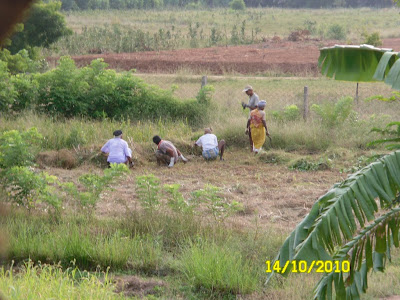smelling a chance to use this opportunity to convert this patch into a natural farming process, we jumped this chance.
simply explained, the NF approach emphasises on 'no-tilling' and 'permanent cover' over and above the 'no-chemicals-no-organic-manure' philosophy.
the master, masanobu fukuoka, pioneered this approach and has beautifully explained this in his books. of course, there are a host of other farmers who have used this method for ages.
so here we are making the baby steps towards fukuoka.
clearing the field (all the ragi stalks and weeds) were cut at ground level and laid down at the same spot.
just prior to this, we sowed a mix of seeds (cow pea, daincha and sunn hemp).
so as we stomp through the field for chopping, these seeds embed into the soil.

we used the csm-patented carpet roll technique :-)
the team squats in a line, directly faces the grass and each member cuts the grass in a continuous line and then rolls the cut grass away from themselves like a carpet.


the tough part is the roll back of the carpet.
and to our surprise, the carpet was not sufficient to fully cover the field.
we had to move out of the classic approach here, by chopping the bordering glyricidia trees (excellent green manure) and dropping it into the gaps.

here is the team enjoying the outing in the sun.


here is the final field as it looks.
look carefully at the background in above and below images to understand where the glyricida trees were .


and within 4 days, the sprouts of the green manure show up.

in a couple of months, when our next planting season arrives (early to mid december), these will again be chopped and dropped and we shall move onto the next crop.
6 comments:
dear csm - have you ever noticed faster composting of mulch that has been sprayed with jeevamruth or amruth pani? better soil texture? more micro-organisms, earthworms? apparently one gram of desi cow dung has 3 billion micro-organisms according to subhash palekar, so wondering if there is a difference, and how long does it take for the difference to show up.
from the pictures, it does look like you have built a good deal of mulch, that it is hard to believe that you started with "wasteland".
anon - have not noticed these comparisons. in fact, we have not used these concoctions since our early days.
palekar is well acknowledged in these matters and i shall respect his data.
this particular plot was 'created' by DV with some soil from the pond in 2007. he has himself grown some crops in 2008.
we added tons of biomass prior to the ragi planting. and with the ragi stalks + weeds + stray cow pea(which grew over 5.5 months), the mulch has reached to this level.
hope this is helpful.
I think Fukuoka described flooding/wetting the field temporarily (after cutting and reaping the crop and putting back the cuttings to the field) to hasten and improve composting, in his book-one straw revolution. However this may not be necessary if it rains of course.
kishore - correct on both counts :-)
dear csm - any reasons for not using the cow dung and cow urine based concoctions?
r - many reasons.
1. access to regular cow dung has ceased since a couple of months.
2. we are not convinced that the effort is worth it.
3. most importantly, in natural farming systems, such concoctions find no place.
as an idea to move to 'fukuoka's' we have stopped doing those concoctions.
Post a Comment